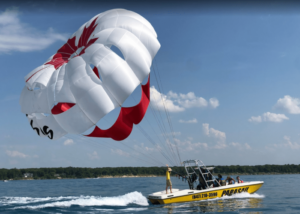
Jet ski adventures near me invites you to dive into an exhilarating world where the waves and wind combine to create unforgettable experiences. Whether you’re a seasoned rider or a curious beginner, the thrill of slicing through the water at high speeds is something that can’t be overlooked.
With numerous rental locations dotting the coastlines, jet skiing offers not just an adrenaline rush, but also the opportunity to explore beautiful waterways. Safety guidelines are crucial, ensuring that every adventure is not only exciting but also responsible. Let’s explore the ins and outs of this exciting water sport!
Jet Ski Adventures Overview
Jet skiing is an exhilarating water sport that combines the thrill of speed with the joy of exploring beautiful coastal waters. This watercraft activity allows riders to glide across the surface, making sharp turns and experiencing the freedom of the open sea. Whether you’re a seasoned pro or a first-timer, jet skiing offers a unique blend of excitement and adventure that attracts enthusiasts of all ages.Popular locations for jet ski rentals are typically found in coastal areas known for their stunning scenery and vibrant aquatic life.
Destinations such as Miami Beach, Hawaii, and the Florida Keys are renowned for their jet skiing opportunities. In these locations, visitors can easily access rental services, ensuring a hassle-free experience. Additionally, many resorts and local businesses offer guided tours, which allow riders to discover hidden coves and enjoy the beauty of marine environments.
Safety Measures and Guidelines for Jet Skiing
Safety is paramount when it comes to enjoying jet skiing. Adhering to guidelines not only ensures a fun experience but also protects riders from potential accidents. Riders should always wear life jackets, regardless of their swimming ability, as this is a crucial safety precaution. To further enhance safety on the water, consider the following essential guidelines:
- Familiarize yourself with local regulations regarding jet skiing, including speed limits and restricted areas.
- Check the weather conditions before heading out to avoid rough waters and storms.
- Maintain a safe distance from other watercraft and swimmers to prevent collisions.
- Never ride alone; it’s safer to jet ski with a buddy or as part of a guided group.
- Ensure your jet ski is in good working condition before each use, including checking fuel levels and engine operation.
- Take an introductory safety course if you’re new to jet skiing to understand the fundamentals of operation and safety protocols.
Always prioritize safety to ensure a memorable and enjoyable jet skiing experience.
In addition to these guidelines, it’s essential to be aware of personal limits and to practice responsible riding. By respecting the environment and other water users, riders can enjoy the thrill of jet skiing while contributing to the safety and enjoyment of everyone on the water.
Related Water Sports Experiences

Engaging in water sports offers a thrilling escape from everyday life while also providing the opportunity to explore beautiful waterways. Among the various options, jet skiing stands out for its speed and excitement. However, other water sports like wakeboarding and parasailing also deliver unique experiences and benefits, catering to different preferences and skill levels.When it comes to comparing water sports, each has its own charm and requirements.
Jet skiing is all about speed and maneuverability, allowing riders to zip across the water and perform sharp turns. In contrast, wakeboarding combines elements of surfing and snowboarding, where riders are towed behind a boat on a board, executing tricks and jumps. Parasailing, on the other hand, offers breathtaking views as individuals are lifted into the air while being towed by a boat, providing a more serene experience.
Each sport has its unique appeal, catering to different types of adrenaline seekers.
Benefits of Water Sports for Physical Fitness
Participating in water sports contributes significantly to physical fitness, offering a full-body workout that enhances strength, flexibility, and endurance. Engaging in activities like jet skiing, wakeboarding, or parasailing can actively improve cardiovascular health while targeting various muscle groups. The benefits of water sports include:
- Improved Cardiovascular Health: Water sports elevate heart rate, promoting better circulation and lung capacity.
- Strength Building: Activities such as wakeboarding require core stability and strength, especially in the arms and legs, enhancing overall muscle tone.
- Enhanced Flexibility: Maneuvering through water challenges the body’s flexibility, helping to prevent injuries.
- Stress Relief: Being on the water can have calming effects, reducing stress levels and promoting mental well-being.
Essential Equipment and Gear for Water Sports
Before diving into any water sport, having the right equipment is crucial for safety and performance. Each activity requires specific gear, ensuring both fun and protection. Here’s a breakdown of essential items for popular water sports:
- Jet Skiing:
- Personal Flotation Device (PFD): Ensures safety on the water.
- Wet Suit: Provides warmth and protection against impacts.
- Safety Whistle: Aids in signaling for help if needed.
- Wakeboarding:
- Wakeboard: The board used for riding.
- Bindings: Secure the rider’s feet to the board.
- Helmet: Protects the head from falls and impacts.
- Parasailing:
- Safety Harness: Connects the rider to the parachute.
- Life Jacket: Essential for buoyancy and safety.
- Boat Equipment: Necessary for towing and safe operation.
In conclusion, water sports, whether it’s jet skiing, wakeboarding, or parasailing, not only offer excitement but also promote fitness and well-being through enjoyable physical activity. Engaging in these sports adds variety to your outdoor adventures while keeping your body active and healthy.
Legal Considerations and Regulations
Before hitting the waves on a jet ski, it’s essential to understand the various legal considerations and regulations that govern their use. These laws can vary significantly from one region to another, influencing everything from age restrictions to safety equipment requirements. Familiarizing yourself with these regulations not only ensures compliance but also enhances safety and environmental stewardship on the water.
Laws and Regulations Governing Jet Ski Usage
Jet ski regulations differ based on the governing bodies of each region. Common legal aspects include registration requirements, age limits for operators, and mandated safety equipment. Here are some typical regulations that operators may encounter:
- Registration: Most states require that all watercraft, including jet skis, be registered with the local authority. This process typically involves providing proof of ownership and paying a registration fee.
- Operator Age Restrictions: Many regions have minimum age requirements for operating a jet ski. For example, in the U.S., most states require operators to be at least 14 or 16 years old.
- Safety Equipment: It’s often mandated that operators wear life jackets and have other safety gear onboard, such as fire extinguishers and sound signaling devices.
Insurance Options for Jet Ski Owners and Renters
Insurance is an important consideration for both jet ski owners and renters, providing financial protection against accidents and liabilities. Here are some common insurance options available in the market:
- Liability Insurance: This is essential for covering damages caused to other people or property during an accident.
- Comprehensive Insurance: This type of policy protects against theft, damages from natural disasters, and vandalism.
- Personal Injury Protection: This type of coverage helps cover medical expenses for injuries sustained while operating the jet ski.
- Rental Insurance: For renters, many rental companies offer insurance options that can be purchased separately to cover damages incurred during the rental period.
Legal Responsibilities of Jet Ski Operators
Jet ski operators have a legal responsibility to ensure the safety of themselves and others on the water. This includes adhering to local laws and being aware of their impact on the environment. Key responsibilities include:
- Following Speed Limits: Many waterways have designated speed limits, especially in crowded areas or near wildlife habitats. Adhering to these limits helps prevent accidents and protects marine life.
- Respecting No-Wake Zones: Operators must be aware of and comply with no-wake zones, which are typically established in areas where boats can disrupt wildlife or other water activities.
- Environmental Awareness: Jet ski users are responsible for minimizing their environmental impact by avoiding shallow waters and nesting areas, and properly disposing of waste.
“Understanding and adhering to local laws and regulations is vital for ensuring a safe and enjoyable jet skiing experience while preserving the environment.”
Final Thoughts

In conclusion, jet ski adventures near me promise an exciting escape into nature, coupled with the thrill of speed and the freshness of the sea breeze. From understanding safety measures to knowing your legal responsibilities, being informed allows you to make the most of your jet skiing experience. So gear up, find your nearest rental, and embark on an adventure that’s just waiting for you!
FAQ Overview
What are the age requirements for jet skiing?
Most locations require riders to be at least 16 years old, but this can vary, so check local regulations.
Do I need a license to rent a jet ski?
Some areas require a boating license or completion of a safety course, while others do not.
What should I wear while jet skiing?
A swimsuit, a life jacket, and sunscreen are recommended for comfort and safety.
Can I jet ski in any body of water?
No, jet skiing is typically restricted to designated areas to ensure safety and protect the environment.
What happens if the jet ski breaks down?
Most rental companies provide assistance or have emergency protocols in place, so you won’t be stranded.





